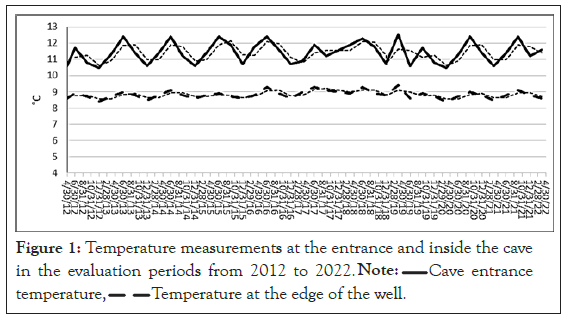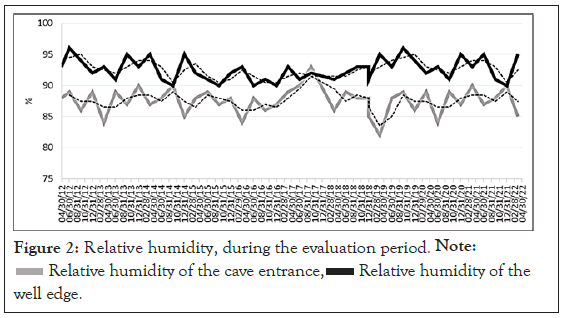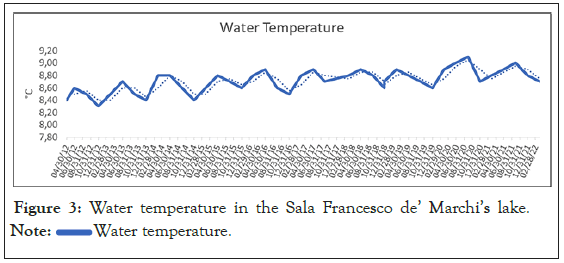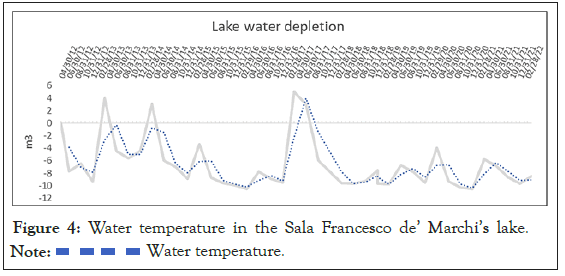Journal of Geology & Geophysics
Open Access
ISSN: 2381-8719
ISSN: 2381-8719
Research Article - (2022)Volume 11, Issue 3
Global warming is a present reality, destined to progress inexorably. The underground environments appear as a complex interface between the atmosphere-lithosphere and the hydrosphere and, in general, the underground temperatures tend to have oscillations linked to the morphological and geological characteristics of the cavity. In Italy, ISTAT data relating to meteo-climatic statistics for the years from 1971 to 2016 show a generalized upward trend thermal. To evaluate any means for the conservation of the present ecosystems and the possible effects deriving from the processes of climate change, we monitored climatic and environmental parameters inside the Grotta a Male (a fossil sinkhole near L'Aquila, Italy, latitude: 42°26′00.5″ North; longitude: 13 °28′26.42″ East), to identify signs of hypogeal climate change, in relation to the current thermal anomalies recorded in the Abruzzo capital. The following assessments were carried out: temperature (°C) at the entrance; temperature at the edge of the well (°C); relative humidity (%) at the entrance and at the edge of the well; the variation of the level (m3) and of the temperature of the water in the lake of the Francesco De' Marchi room (°C). The surveys were carried out from 2012 to 2022 with 4 annual evaluations for the months of March-April, June-July, September-October and December-January. Our data show an increase in the average temperature in the cave of approximately 0.3°C-0.4°C per year, with a simultaneous increase in internal relative humidity of approximately 2%-3% per year.
Global warming; Climate change; Meteo-climatic statistics
Current weather-climate data and indicators confirm that global warming is already a present reality, destined to progress inexorably [1], with possible impacts on public health [2]. The increase in the average annual temperature is characterized by an increase in days of extreme heat, tropical nights, and absolute minimums of minimum and maximum temperatures [3,4]. The number of days with frost and cold nights decreased in almost all the Italian regional capitals, confirming the results of the main meteorological and climatic studies on an international scale.
In Italy, ISTAT data relating to meteo-climatic statistics for the years from 1971 to 2016 [5], collected by thermo-pluviometric monitoring stations, located in 21 regional capitals, show a generalized upward trend thermal for the stations examined. Current research indicates that the climate change point is to be traced to the early 1980s in Italy, when the positive growth of average temperatures took on a trend of constant increase (change point). The underground environments appear as a complex interface between the atmosphere-lithosphere and the hydrosphere and, in general, the underground temperatures tend to have values close to the Epigean annual averages with annual oscillations linked to the morphological and geological characteristics of the cavity [6]. The "Climate change and carbon cycle in canyons and caves" project had the objective of monitoring the climatic and environmental parameters inside gorges and caves, with particular reference to the concentrations of carbon dioxide in the atmosphere, the atmospheric conditions of temperature and humidity and the intensity of precipitation and drips, to evaluate any means for the conservation of the present ecosystems and the possible effects deriving from the processes of climate change. The data collected in the study came from seven measurement sites located between Jordan and the northern Apennines [6].
In line with the speculations of Madonia, et al. [6], the speleological group of National Alpine and Cave Rescue Corps (NACRC) of L'Aquila (Italy) monitored climatic and environmental parameters inside the Grotta a Male, an underground cavity located in the Vasto valley, near Assergi in the province of L'Aquila (Italy), to identify signs of hypogeal climate change, in relation to the current thermal anomalies recorded in the Abruzzo capital.
Geological and microclimatic data of "Grotta a Male" (Assergi, L'Aquila, Italy)
Grotta a Male is a cavity located in the Vasto valley, near Assergi, in the province of L'Aquila, and it is the largest cave in the Gran Sasso massif [7]. The underground cavity was made famous by Captain Francesco de Marchi, who explored it on August 20, 1573; it has a development of 480 m with a maximum depth of 84 m. The main axis coincides with the Raiale stream which flows 60 m further down; the entrance is located at 956 m and consists of a 35 m long fossil sinkhole (Latitude: 42°26′00.5″ North; Longitude: 13°28′26.42″ East). Beyond the entrance there is a large room (Sala del Tronco) from which starts a sinuous helical tunnel that allows access to the largest room of the entire cave, the Sala dei Colossi, with a length greater than 55 m and the bottom cluttered with large limestone boulders.
From here three branches branch off: on the right the Ramo d’Organo and at the end of the room, two branches are connected to each other by a permanently flooded siphon (The Ramo delle Pannocchie e dei Laghi with the Ramo della Sala de Marchi). Going down the Sala dei Colossi, along the lower left wall, you reach the edge of a well which, with a jump of 15 m, allows you to access a large room, from which the Ramo delle Pannocchie and the Ramo dei Laghi branch off, where there are a lake and an active spring. Walking through the Sala dei Colossi along the lower right wall, you enter in the Sala della Croce through a narrow downhill passage and from here you arrive in the Sala de Marchi from which the joint homonymous lake is easily visible, through a flooded siphon of 20 m, with the branch of the lakes [7]. The level of the lakes is not constant but shows excursions of over 6 meters in relation to the seasonal cycle, with the minimum in December and the maximum in April-May. From the meteorological point of view, the cavity is to be classified among those of the airbag type with an opening at the top (in which cold air tends to collect). The air temperature in the innermost part of the cavity is between 8.1°C and 9.2°C, with minimal differences between the various seasons. The water temperature of the terminal lakes fluctuates between 9°C and 9.2°C. Relative humidity averages around 90% (4 ≥ 8).
Climatic evaluations carried out at “Grotta a male”
The following assessments were carried out: temperature (°C) at the entrance; temperature at the edge of the well (°C); relative humidity (%) at the entrance and at the edge of the well; the variation of the level (m3) and of the temperature of the water in the lake of the Francesco De' Marchi Room (°C). The surveys were carried out from 2012 to 2022 with 4 annual evaluations for the months of March-April, June-July, September-October and December-January. Data relating to temperature and relative humidity were collected using the RH81 thermo-hygrometer (Omega Engineering Limited River Bend Technology Center Northbank, Irlam, Manchester M44 5BD United Kingdom).
The Leica DISTO D510 meter (Leica DistoTM, Swiss Technology, by Leica Geosystems) was used to measure the change in the water level; the period March-April 2012 was considered the zero-starting point for the measurement. For the calculation of the volumetric deflection (m3) of the water level, the collected measurements were elaborated using AutoCAD® (Autodesk) software.
The climatic evaluations were carried out during targeted excursions performed by members of the speleological group of NACRC of L'Aquila (Italy).
Data relating to the epigeal climatic variations in the city of L'Aquila (Italy)
The data for the epigeal atmospheric temperatures for the city of L'Aquila were extrapolated from the Meteoclima report of the Italian National Institute of Statistics (ISTAT) [5].
Statistical analysis
Descriptive statistics were reported for all investigated variables. For each variable, monthly measures were plotted to investigate trend and seasonality, adding a moving average line to the chart (period: 2). Multiple comparisons of annual data were performed using Tukey-Kramer because of unequal group sizes.
Climatic variations inside "Grotta a Male"
Table 1 shows the descriptive statistics variables analyzed, while Table 2 reports the annual data and the comparison of the average values per year. For the months of March-April of 2012 and 2022, the average temperatures recorded at the entrance to the cave showed respectively a positive variation from 10.6°C to 11.6°C. Inside the underground cavity at the level of the well the average temperature recorded for the months of March-April 2012 was 8.6°C.
| Statistics | Water lake | Temperature | Relative humidity | ||
|---|---|---|---|---|---|
| Temperature | Depletion (m3) | Cave entrance | At the edge of the well | Cave entrance | |
| Count | 41 | 41 | 41 | 41 | 41 |
| Mean | 8, 710 | -6, 641 | 11, 407 | 8, 827 | 0, 876 |
| Standard deviation | 0, 183 | 4, 126 | 0, 654 | 0, 241 | 0, 021 |
| Standard error | 0, 029 | 0, 644 | 0, 102 | 0, 038 | 0, 003 |
| Lower 95% CL mean | 8, 652 | -7, 944 | 11, 201 | 8, 751 | 0, 869 |
| Upper 95% CL mean | 8, 767 | -5, 339 | 11, 614 | 8, 903 | 0, 883 |
| Median | 8, 700 | -7, 800 | 11, 400 | 8, 800 | 0, 880 |
| Minimum | 8, 300 | -10, 500 | 10, 500 | 8, 400 | 0, 820 |
| Maximum | 9, 100 | 5, 000 | 12, 500 | 9, 400 | 0, 930 |
| Interquartile range | 0, 200 | 3, 850 | 1, 150 | 0, 300 | 0, 030 |
Table 1: Statistics variables analyzed.
| Year | Water lake | Temperature | Relative humidity | |||||||||
|---|---|---|---|---|---|---|---|---|---|---|---|---|
| Temperature | Depletion (m3) | Cave entrance | At the edge of the well | Cave entrance | On the well edge | |||||||
| Mean | SD | Mean | SD | Mean | SD | Mean | SD | Mean | SD | Mean | SD | |
| 2012 | 8, 50 | 0, 10 | -4, 73 | 4, 14 | 11, 03 | 0, 59 | 8, 73 | 0, 15 | 87, 67 | 1, 53 | 94, 33 | 1, 53 |
| 2013 | 8, 50* | 0, 16 | -3, 85 | -3, 85 | 11, 40 | 0, 78 | 8, 73 | 0, 25 | 87, 25 | 2, 36 | 92, 75 | 1, 71 |
| 2014 | 8, 65 | 0, 19 | -3, 63 | -3, 63 | 11, 40 | 0, 75 | 8, 80 | 0, 24 | 88, 75 | 1, 50 | 92, 25 | 2, 22 |
| 2015 | 8, 63 | 0, 17 | -7, 65 | -7, 65 | 11, 58 | 0, 77 | 8, 75 | 0, 13 | 87, 25 | 1, 71 | 92, 00 | 2, 16 |
| 2016 | 8, 73 | 0, 15 | -9, 28 | -9, 28 | 11, 63 | 0, 70 | 8, 90 | 0, 29 | 86, 50 | 1, 91 | 91, 50 | 1, 29 |
| 2017 | 8, 73 | 0, 17 | -1, 88 | -1, 88 | 11, 18 | 0, 53 | 9, 00 | 0, 29 | 89, 75 | 2, 50 | 91, 50 | 1, 29 |
| 2018 | 8, 78 | 0, 13 | -9, 00 | -9, 00 | 11, 68 | 0, 68 | 8, 98 | 0, 22 | 87, 75 | 1, 26 | 92, 25 | 0, 96 |
| 2019 | 8, 78 | 0, 10 | -8, 50 | -8, 50 | 11, 40 | 0, 88 | 8, 93 | 0, 34 | 86, 00 | 3, 16 | 93, 75 | 2, 22 |
| 2020 | 8, 90* | 0, 22 | -8, 28 | -8, 28 | 11, 25 | 0, 83 | 8, 70 | 0, 24 | 87, 00 | 2, 45 | 92, 50 | 1, 29 |
| 2021 | 8, 85 | 0, 13 | -7, 93 | -7, 93 | 11, 45 | 0, 74 | 8, 80 | 0, 24 | 88, 00 | 1, 41 | 93, 50 | 1, 91 |
| 2022 | 8, 75 | 0, 07 | -9, 10 | -9, 10 | 11, 40 | 0, 28 | 8, 70 | 0, 14 | 87, 50 | 3, 54 | 92, 50 | 3, 54 |
Note: *Comparison significant: Tukey-Kramer Multiple-Comparison Test, p<0.05.
Table 2: Annual data.
In the same months of 2022 the average temperature was the same. In Figure 1 it is possible to follow the bimonthly temperature measurements at the entrance and inside the cave in the evaluation periods from 2012 to 2022. During the summer months, as expected, the temperature at the entrance and inside the cave reaches constantly its highest peaks from 2013 to 2016 and from 2020 to 2021 [8].

Figure 1: Temperature measurements at the entrance and inside the cave in the evaluation periods from 2012 to 2022. Note: Cave entrance temperature,
Cave entrance temperature,  Temperature at the edge of the well.
Temperature at the edge of the well.
The relative humidity at the entrance of the underground cavity was 88% in the period of March-April of 2012; in the same period of 2022 was about 82%. At the level of the internal well, the relative humidity was about 93% in the period of March-April 2012 and about 95% in the same months of 2022 (Figure 2).

Figure 2: Relative humidity, during the evaluation period. Note: Relative humidity of the cave entrance,
Relative humidity of the cave entrance,  Relative humidity of the well edge.
Relative humidity of the well edge.
The water temperature showed positive variations of approximately 0.5°C in the cold months of the year (December-January) and of approximately 1.2°C in the hot months (June-July). The data series shows the presence of seasonality with an increasing trend even if the latest data were collected till March 2022 (Figure 3). The water level exceeded the zero level in the years 2013-2014 and 2017, as shown in Figure 4.

Figure 3: Water temperature in the Sala Francesco de’ Marchi’s lake. Note:  Water temperature.
Water temperature.

Figure 4: Water temperature in the Sala Francesco de’ Marchi’s lake. Note:  Water temperature.
Water temperature.
The surveys carried out for the years from 2012 to 2022 show an increase in the average temperature in the cave of approximately 0.3°C-0.4°C per year, with a simultaneous increase in internal relative humidity of approximately 2%-3% per year. The temperature outside the cave increases in the same way as the positive variation of the epigeal atmospheric temperature in line with the averages of the estimated global warming: 0.5°C-2.2°C as a seasonal and annual trend, with a reduction in relative humidity at the entrance, evidently linked to a reduction in the amount of rainfall. As regards the change in the epigeal climatic variables considered, the data relating to the last 15 years of observation (2002-2016) compared with the average values of the thirty years 1971-2000 on an international scale, show that after 1996 the national Italians average temperatures take on increasingly positive values. The three-year period 2014-2016 was the hottest since 1971, with an average temperature abnormal rise equal to +1.3°C, compared to the average annual climatic value [5]. The average of the percentage variations, in the three years indicated, is higher for the capitals of Central Italy. The city of L'Aquila (Italy) showed an average annual temperature of 12.8°C from 2000 to 2016, with an annual positive percentage change of 7.3%, compared to the years 1971 to 2000 (average annual temperature 11.9°C), despite the analysis of the minimum temperatures recorded documents a decreasing trend [5].
To all this must be added the reduction of precipitation, in particular snow, with a percentage reduction in the Abruzzo capital of 6.6% of the climatic value. There was a reduction in rainfall from 686.1 mm per year for the three-year period 1971- 2000 to 640.6 for the years from 2000 to 2016, with an absolute negative peak for the two-year period 2015-2016. This could influence the filling of the lakes inside the underground cavity; in particular, the level of water contained in the pond of the Sala Francesco de' Marchi seems to decrease by approximately 15% per year, with a minimum recorded during the evaluations of 2019. The evaluations of this study are affected by some methodological limitations; in fact, the hypogeal climatic values were recorded over a period of two months on different days, without considering the contextual epigeal atmospheric manifestations. In addition, the climatic values were recorded for a very short time frame, and this is the greatest drawback of this research. For the assessments of temperature and relative humidity, it would have been appropriate to evaluate any variations in the ventilation inside and outside the cavity, the presence of new communications with the outside and the evaluation of the heating of the rock component in relation to the intensity of solar radiation. The calculation of the deviation of the water level present in the lake of the Sala Francesco de' Marchi was carried out using the measurements of height, depth and width of the cavity that houses it, considering it as a parallelepiped.
In conclusion, the hypogeal environments could be affected by epigeal climatic variations although it is necessary to consider them as a complex interface between the atmosphere-lithosphere and the hydrosphere. The hypogeal climatic variables have values close to the epigean annual averages with oscillations linked to the morphological and geological characteristics of the cavity. This study, despite its methodological limitations, could provide useful information not just for the protection of local ecosystems from ongoing global climate warming, but also for the protection of the ecosystems of planet Earth.
[Crossref] [Google Scholar] [PubMed]
[Crossref] [Google Scholar] [PubMed]
[Crossref] [Google Scholar] [PubMed]
[Crossref] [Google Scholar] [PubMed]
Citation: Emiliano P, Cofini V, Pizzi B, Marrocco G, Ceccaroni G, Necozione S, et al. (2022) Hypogeal Climate Changes: 10 Years of Reliefs at Grotta a Male, Assergi, L'Aquila (Italy). J Geol Geophys. 11:1021.
Received: 06-Apr-2022, Manuscript No. JGG-22-16702; Editor assigned: 08-Apr-2022, Pre QC No. JGG-22-16702 (PQ); Reviewed: 22-Apr-2022, QC No. JGG-22-16702; Revised: 29-Apr-2022, Manuscript No. JGG-22-16702 (R); Published: 06-May-2022 , DOI: 10.35248/2381-8719.22.11.1021
Copyright: © 2022 Emiliano P, et al. This is an open-access article distributed under the terms of the Creative Commons Attribution License, which permits unrestricted use, distribution, and reproduction in any medium, provided the original author and source are credited.